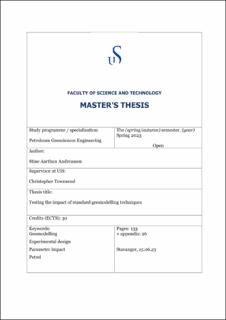| dc.description.abstract | Geomodelling is an important tool in the oil and gas industry, it gives a visual 3D representation of the subsurface. In order to construct a 3D representation of the subsurface a comprehensive building process is required, and several modelling techniques is used. If these modelling techniques are not followed strictly, it can have significant impact on volume calculations. The construction of two geologically different models and several complex workflows will test the impact of standard and non-standard modelling techniques used for permeability, porosity, and water saturation to see the impact on the volume calculations, specifically pore volume, HCPV oil, HCPV gas, STOIIP and GIIP. Different input parameters will be tested in Petrel using a full-factorial experimental design setup, and then compare the experiment models to the real-case models. The parameters tested are layering, the nr. of wells, most of vs. mid-point pick, vertical proportion curve (VPC), bias to facies on vs. off, Sequential Gaussian simulation (SGS) vs. Kriging, variogram range for porosity and permeability, with vs. without depth trend, the correlation coefficient for permeability, normal vs. asymmetric distribution and the saturation height function. The findings show that the tested parameters do have an impact on the calculated volumes. The impact varies from model to model and from parameter to parameter, and some parameters have a larger impact than others. | |
